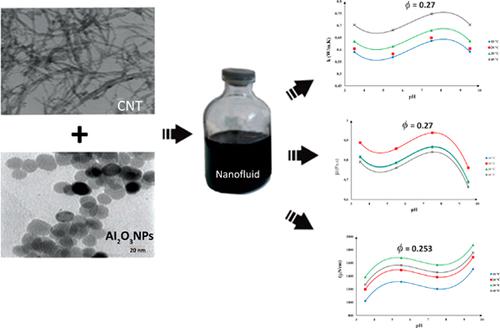Current Nanoscience ( IF 1.4 ) Pub Date : 2020-09-30 , DOI: 10.2174/1573413716666191218122600 Amir Hossein Sharifi 1 , Iman Zahmatkesh 1 , Fatemeh F. Bamoharram 2 , Amir Hossein Shokouhi Tabrizi 3 , Safieh Fazel Razavi 2 , Sara Saneinezhad 2

|
Background: Hybrid nanofluids are considered as an extension of conventional nanofluids which are prepared through suspending two or more nanoparticles in the base fluids. Previous studies on hybrid nanofluids have measured their thermal conductivity overlooking other thermophysical properties such as viscosity and electrical conductivity.
Objective: An experimental investigation is undertaken to measure thermal conductivity, viscosity, and electrical conductivity of a hybrid nanofluid prepared through dispersing alumina nanoparticles and multiwall carbon nanotubes in saltwater. These properties are the main important factors that must be assessed before performance analysis for industrial applications.
Methods: The experimental data were collected for different values of the nanoparticle volume fraction, temperature, salt concentration, and pH value. Attention was paid to explore the consequences of these parameters on the nanofluid’s properties and to find optimal conditions to achieve the highest value of the thermal conductivity and the lowest values of the electrical conductivity and the viscosity.
Results: The results demonstrate that although the impacts of the pH value and the nanoparticle volume fraction on the nanofluid’s thermophysical properties are not monotonic, optimal conditions for each of the properties are reachable. It is found that the inclusion of the salt in the base fluid may not change the thermal conductivity noticeably. However, a considerable reduction in the viscosity and substantial elevation in the electrical conductivity occur with an increase in the salt concentration.
Conclusion: With the addition of salt to a base fluid, the thermophysical properties of a nanofluid can be controlled.
中文翻译:

氧化铝-MWCNTs /盐水杂化纳米流体的热物理性质的实验测量
背景:杂化纳米流体被认为是常规纳米流体的扩展,该常规纳米流体是通过将两种或更多种纳米颗粒悬浮在基础流体中而制备的。以前对混合纳米流体的研究已经测量了它们的热导率,而忽略了其他热物理特性,例如粘度和电导率。
目的:进行实验研究以测量通过将氧化铝纳米颗粒和多壁碳纳米管分散在盐水中制备的杂化纳米流体的导热率,粘度和电导率。这些性能是工业应用性能分析之前必须评估的主要重要因素。
方法:收集纳米颗粒体积分数,温度,盐浓度和pH值的不同值的实验数据。注意研究这些参数对纳米流体性能的影响,并找到最佳条件以实现最高的热导率值以及最低的电导率和粘度值。
结果:结果表明,尽管pH值和纳米颗粒体积分数对纳米流体的热物理性质的影响不是单调的,但可以达到每种性质的最佳条件。发现在基础流体中包含盐可能不会显着改变热导率。然而,随着盐浓度的增加,出现粘度的显着降低和电导率的显着提高。
结论:在基础流体中添加盐可以控制纳米流体的热物理性质。











































 京公网安备 11010802027423号
京公网安备 11010802027423号